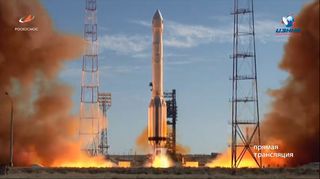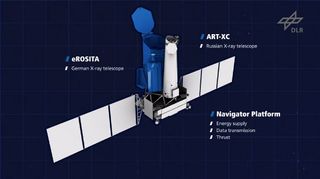A Russian and European all-sky-survey satellite is safely in space following a successful launch on a Proton rocket in Saturday (July 13).
The Spektrum-Röntgen-Gamma mission, also known as Spektr-RG, is a joint project between the Russian space agency, Roscosmos, and the German space agency, DLR. Spektr-RG launched to space from the Baikonur Cosmodrome in Kazakhstan at 8:31 a.m. EDT (1231 GMT, or 5:31 p.m. local time).
Saturday's launch followed weeks of delays. An attempt to launch the Spektr-RG mission on June 21 was delayed by a battery drain on the Proton rocket's Block DM upper stage, according to Spaceflight Now. Roscosmos then postponed a second launch attempt Friday (July 12) due to an potential issue with the booster.
Related: Behold! This Stunning Light Art Is Actually a Sky Filled with X-Rays

A Russian Proton-M rocket launches the international Spektr-RG X-ray space observatory for Roscosmos and the German Aerospace Center from Baikonur Cosmodrome, Kazakhstan on July 13, 2019.
(Image credit: Roscosmos)

This still image from a German Aerospace Center video shows the arrangement of Russian and German X-ray telescopes on the Spektr-RG space observatory.
(Image credit: DLR/German Aerospace Center)
Spektr-RG will next navigate to a stable orbit in space called a Lagrange point (specifically, L2), where the gravitational forces of two large objects — in this case, the sun and the Earth — balance each other out. This location will allow Spektr-RG to perform its observations while using a minimal amount of fuel.
The spacecraft is expected to detect 100,000 galaxy clusters, 3 million supermassive black holes, tens of thousands of star-forming galaxies, the presence of plasma (superheated gas) and many more types of objects, according to Roscosmos.
The observatory includes two X-ray mirror telescopes, called ART-XC and eROSITA. ART-XC (a Russian payload) will examine the higher energies of X-rays, up to 30 keV, while eROSITA (Extended Roentgen Survey with an Imaging Telescope Array) is optimized for an energy range of 0.5 to 10 keV.
KeV is a measure referring to electrical potential difference. A single electron volt (eV) is a unit of energy equal to the amount of energy an electron (negatively charged particle) gains when it is accelerated from rest through a potential difference of 1 volt. A kiloelectron volt (keV) is equal to 1,000 electron volts.
ART-XC will have a narrower field of view and is designed to look at objects with a lower range of energies than eROSITA, according to Russian Space Web's Anatoly Zak. "The overlap in the sensitivity of eROSITA and ART-XC was reported to be useful for the calibration of the two instruments and increasing the reliability of their scientific results," he wrote.
Spektr-RG is expected to be calibrated in about three months; it will then perform its survey.
Follow Elizabeth Howell on Twitter @howellspace. Follow us on Twitter @Spacedotcom and on Facebook.
https://www.space.com/russia-launches-x-ray-space-observatory-spektr-rg.html
2019-07-13 12:46:00Z
CBMiTGh0dHBzOi8vd3d3LnNwYWNlLmNvbS9ydXNzaWEtbGF1bmNoZXMteC1yYXktc3BhY2Utb2JzZXJ2YXRvcnktc3Bla3RyLXJnLmh0bWzSAQA
Tidak ada komentar:
Posting Komentar